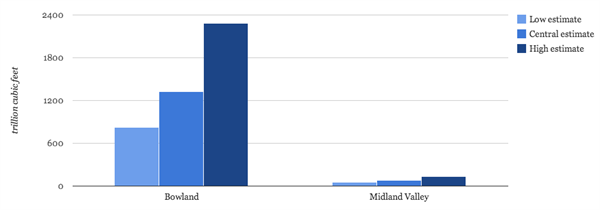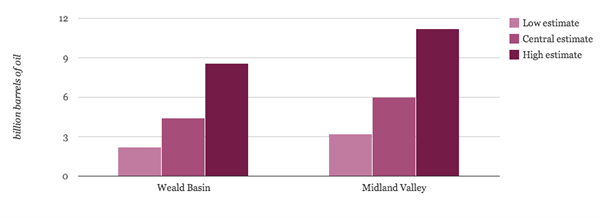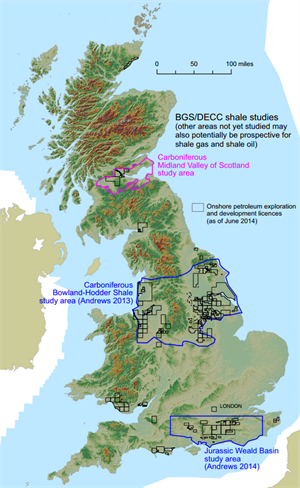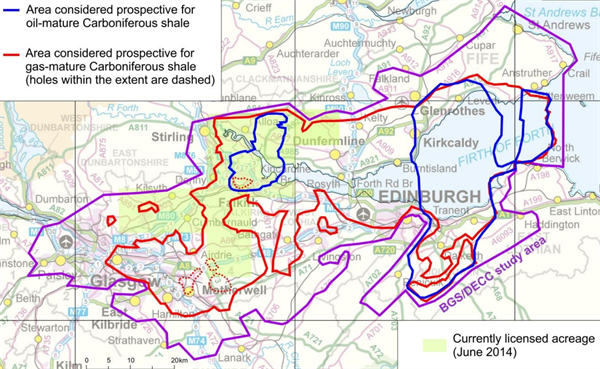Scotland may have some hard to reach shale oil, but not much shale gas, according to new estimates.
A new study by the British Geological Survey (BGS) released today suggests southern Scotland’s Midland Valley may only have a fraction of the shale gas resources thought to be in northern England. The region between Glasgow and Edinburgh may have shale oil resources to rival those supposedly in England’s south, however.
The report warns that it is “not yet possible” to ultimately know how much oil and gas Scotland’s shale may produce.
How much is there?
BGS used mapping tools and data from existing oil and gas wells to predict the size of the resources. It gives three estimates of how much oil and gas there may be based on the model’s results: low, central, and high.
BGS estimates there could be in the range of 49 to 135 trillion cubic feet (tcf) of gas locked in shale rock in Scotland’s Midland Valley. It’s central estimate is around 80 tcf – about six per cent of the resource thought to be in Lancashire’s Bowland shale. The UK uses about three tcf of gas each year.

Source: Data from the British Geological Survey, graphs by Carbon Brief
While the survey finds there probably isn’t much shale gas in Scotland, BGS estimates there could be as much as 11.2 billion barrels oil trapped in the same rock – about 30 per cent more than it recently estimated was in the Weald Basin in the south of England.The UK uses 535 million barrels of oil each year. It has 3 billion barrels of oil that are currently known to be recoverable.

Source: Data from the British Geological Survey, graphs by Carbon Brief
BGS doesn’t offer an estimate of how much oil or gas could eventually be extracted from the rock. Its estimates refer to the oil and gas “in-place” in the shale – the total amount that may be underground. That’s different from a ‘reserve’ estimate, which tells you how much you might eventually get out of the ground, and will be lower.
BGS emphasises that “some or all of [Midland Valley’s oil and gas] might never be produced” in a press release accompanying today’s report. That’s partly because the region’s geology could make it difficult for companies to drill exploratory wells. BGS says the Midland Valley shale rock has “thinner shale packages mixed in with volcanic rocks, faults and abandoned deep coal mine working which make it more complex and are likely to limit where wells can be drilled”.
The awkward rock formation also mean today’s resource estimates are highly uncertain, as there were few historic wells for BGS to study, the report says.
Where is it?
Today’s report is BGS’s third shale survey in two years, with previous reports assessing resources in Lancashire and south east England.

Source: British Geological Survey
BGS identifies shale rock stretching from Glasgow to the east coast which could contain oil and gas. Companies currently only have licenses to explore for oil and gas in a small section of the region, as the yellow shading on this map shows:

Source: British Geological Survey
The area’s relatively dense population may be a problem for companies wishing to explore the Midland Valley’s resources, however. Despite being offered improved compensation packages, communities have so far been reluctant to permit fracking in England.
The government recently removed the right of landowners to reject fracking on the basis that such companies would be trespassing to ease prospectors’ paths. But the move caused a minor outcry, with London mayor Boris Johnson being the latest high profile figure to argue that communities deserve a say in what happens to the land beneath their feet.
Uncertain reserves
Today’s report largely fits with BGS’s earlier message that it’s “still too early” to know what role unconventional oil and gas could play in the UK’s energy mix. Since BGS suggested there could be plentiful shale gas reserves in Lancashire last year, it has also emphasised uncertainties over how much could be extracted.
Without companies drilling more exploratory wells, “figures for reserves cannot be reliably estimated”, it says. And until companies have some idea of how much oil or gas can be extracted, it’s impossible to know how much may one day be available to meet the UK’s energy needs.
That message seems to have filtered through to the government. Last year, the prime minister last year urged the UK to go “all out” for shale gas and recently suggested the country had a “duty” to develop domestic resources. Energy minister Michael Fallon qualified that position at a press conference today. He said ministers “know that shale gas alone won’t be able to supply all our energy needs but the environmentally responsible exploration of shale gas could contribute to our energy mix”, the Guardian reports.
But if the government backs a “dash for gas”, it could be putting the country’s climate targets at risk, according to official advisor the Committee on Climate Change. Some shale gas production could curb the UK’s emissions by replacing more polluting energy sources such as coal or imported liquefied natural gas, it says.
But it expresses concern over whether ramping up shale gas production fits with the government’s longer term commitment to decarbonise the energy sector. The Department of Energy and Climate Change’s chief scientist has also expressed concerns over how polluting the fracking process is, raising further questions about shale gas’s low carbon credentials.
Correction, 30/06: The graphs were corrected.

